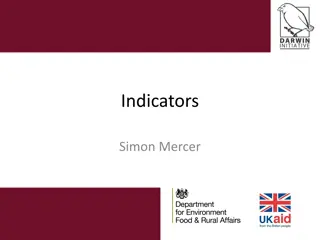Understanding Energy Indicators and Their Significance in Environmental Analysis
Exploring the importance of energy indicators in environmental analysis, this content delves into various types of indicators, such as econometric, physical, and efficiency indicators. It highlights the need for clear objectives in measurement and coherence between energy aspects and activities. Additionally, it emphasizes the limitations of using intensity as a sole indicator for energy efficiency and suggests alternative metrics for a more comprehensive analysis.
Uploaded on Sep 16, 2024 | 0 Views
Download Presentation

Please find below an Image/Link to download the presentation.
The content on the website is provided AS IS for your information and personal use only. It may not be sold, licensed, or shared on other websites without obtaining consent from the author. Download presentation by click this link. If you encounter any issues during the download, it is possible that the publisher has removed the file from their server.
E N D
Presentation Transcript
ESCM Chapter 7 Martin Howley
Overview Background Responses Outline Issues Emissions Decomposition analysis
Background Indicators not merely data provide a deeper understanding of the main issues and to highlight important relations that are not evident using basic statistics Good indicator has a clear objective on what it s supposed to measure Coherence between the energy aspect and the activity International comparability
Background Existing and forthcoming publications UN Sustainability Indicators ODYSSEE Energy Indicators IEA Energy Efficiency Indicators MESH
Background types of indicators Econometric indicators energy intensity Physical indicators energy per tonne, sq metre, passenger km, tonne km, etc Efficiency indicator decomposition analysis Environmental indicator energy-related emission per capita, GDP, kWh etc Indirect indicator motorization rate, appliance label shares, etc Composite ODEX Price cost per energy unit
Background - Responses Focus energy indicators Special focus on energy intensity. However, intensity is a very misleading indicator for energy efficiency. Need to explain why intensity should not be used for energy efficiency. Not sure about if the distance travelled per capita is a good example. Energy use per capita. A need to define what use covers.
Background - Responses Efficiency of energy conversion Industrial energy intensities: There is a need to add energy consumption per tonne of production (cement, iron and still, etc.). It is often more meaningful than intensity. Not sure about useful is Agricultural energy intensities are really meaningful. They are so dependent on so many factors.
Background - Responses Scope to identify usages for public policies of such information: national development plans (including sustainable energy development), and international conventions and protocols. the relevant processes and activities related to production and consumption of energy for the calculation of greenhouse gas emissions
Background - Responses Energy-related greenhouse gas emissions: Emission factors used (if national factors are used, how are they derived?). Some emissions such at nitrous oxides (NOx) depend on how it s consumed in terms of the technology, load factor, etc. The choice of the set of indicators compiled by a country should consider the sustainable development approach, according to its three dimensions: social, economic and environment, as well as according to theme and sub - theme
Outline Introduction What is a good indicator Types of Indicators Data Sources National Indicators Energy intensity Energy per capita
Outline Sectoral Indictors Energy Efficiency versus Energy Intensity
Issues Climate correction Energy Intensity versus Energy Efficiency Monetary value constant values (real)
Greenhouse Gas Emissions IPCCC Emission Factors CO2 NOx SOx, methane etc Emissions trading v non-trading (EU) Emissions Indicators
Decomposition analysis Disaggregate energy consumption, emissions into component parts Changes in consumption related to changes in component activity























